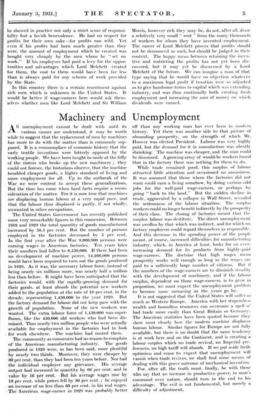Machinery and
Unemployment
AS unemployment cannot be dealt with until its various causes are understood, it may be worth while to suggest that the replacement of men by machines has more to do with the matter than is commonly sup- posed. It is a commonplace of economic history that the early textile inventions were bitterly opposed by the working people. We have been taught to smile at the folly of the rioters who broke up the new machinery ; they could:not foresee, the historians observe, that the machine heralded cheaper goods, a higher standard of living and more employment for all. Up to the outbreak of the War we were content to accept these generalizations. But the time has come when hard facts require a recon- sideration of the matter. For it is now true that machines are displacing human labour at a very rapid pace, and that the labour thus displaced is partly, if not wholly, unwanted in other occupations.
The United States Government has recently published some very remarkable figures in this connexion. Between 1919 and 1929 the total quantity of goods manufactured • increased by 58.5 per cent. But the number. of persons employed- in the factories decreased by 5 per cent. In the first year after the War 9,000,000 persons were earning wages in American factories. Ten years later their numbers had fallen to 8,550,000. If there had been no development of machine power, 14,266,000 persons would have been -required to turn out the goods produced in 1929. As it was, the necessary labour force, instead of being nearly six millions more, was nearly half a million less than before. It might have been anticipated that the :factories would, with the rapidly-growing demand for their goods, - at least absorb the potential new workers added to the population at the rate of 16 per'eent. in the 'decade, representing 1,450,000 in the year 1929. But the factory demand for labour did not keep Pace with the growth of population. None of the new workers was Wanted.. The -extra labour lOree of 1,450,000 Was super- fltious, like the 450,000 Old workers who had been dis- iniaied. Thus nearly two million peoPle who were actually -available for employment in the factories had to look for work elsewhere. The machine had ousted them.
The community as consumers had no reason to-complain or the AMerican manufacturing industry. -The goods produced in 1929 were, as has been said,- more plentiful by nearly two thirds. Moreover, they were cheaper by 36-per Cent. than they*had been ten years before. Nor had the individual employee- any grievance. His average Output had increased in quantity by 66 per cent. and in value 'bY '16 per cent.. But his average • wages "rose by 18 per cent. while prices fell by 30 per cent. ; he enjoyed AA increase of no less than 68 per cent: in his real wages. The Anieriean wage-carder in .1929 was probably better off than any working man has ever been in modern history. Yet there was another side to that picture of abounding prosperity, on the strength of which Mr. Hoover was elected President. Labour was very highly paid, but the demand for it in manufacture was silently shrinking. The machine was cheaper, and the man could be dismissed. A growing army of would-be workers found that in the factory there was nothing for them to do.
While trade remained good, this surplus of labour attracted little attention and occasioned no uneasiness. It was assumed that those whom the factories did not want could earn a living somehow, by doing various odd jobs for the well-paid wage-earners, or perhaps by going " back to the land." But the sudden decline in trade,. aggravated by a collapse in Wall Street. revealed the seriousness of the labour situation. The surplus workers could no longer benefit indirectly by the prosperity of their class. The closing of factories meant. that the surplus labour was destitute. The direct unemployment was swollen by that which was indirect, and for which no factory employers could regard themselves as responsible.
And this decrease in the spending power of the people meant, of course, increased difficulties for manufacturing industry, which, in America at least, looks for an ever- increasing demand for its products from highly-paid wage-earners. The doctrine that high wages mean prosperity works well enough so long as the wages are paid to a sufficiently large number of citizens. But if the numbers of the wage-earners are to diminish steadily with the development of machinery, and if the labour surplus, dependent on those wage-earners, is to grow in proportion, we must expect the unemployment problem to become more menacing as the years go by.
• It is not suggested that the United States will suffer as riuich as WeStern Europe. America with her stupendo:is wealth and boundless resources can overcome a spell of bad trade more easily than Great Britain or Germany. The American statistics have been quoted because they show most clearly how the modern machine displaces human labour. Similar figures for Europe are not fully available, but there is no doubt that the same tendency is at work here and on the Continent, and is creating a labour surplus which no trade revival, no Imperial pre- -ferenees, no high tariff will absorb. If we put aside facile .optiMism and cease to expect that unemployment will vanish when trade revives; we shall find some means of dealing with this graVe outcome of mechanical invention.
For, after all, the truth must, finally, be with those who say that an increase in productive power, in man's command over nature, should turn in the cnd to his advantage: The evil is not fundamental, but merely a difficulty of adjustment.






































 Previous page
Previous page